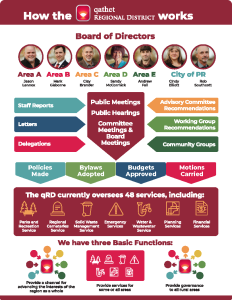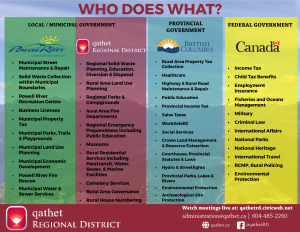How Regional Districts Work
The qathet Regional District is one of 27 regional districts in B.C. Regional districts were created by the Province of British Columbia in 1965 as a response to demands for services from residents living in areas that lay outside the boundaries of existing municipalities.
Regional districts can provide a broad range of services with the exception of roads and policing. Therefore services often vary with each regional district according to its circumstances and local desires. Regional districts also provide administrative services including capital borrowing for all members and act as a political forum for local government policy. Regional districts provide services such as clean water, sewer systems, parks and recreation, land use planning, and fire protection.
The qathet Regional District collaborates with the public, neighbouring governments, and community groups to support a sustainable and prosperous region. This is achieved through the implementation of Strategic and Financial Plans, bylaws, regulations, and work plans. While many services are provided by regional districts, some are handled by other levels of government.
How Services are Financed
Every service has its own group of participants and only those participants pay for the service. Each service has its own separate budget – revenues and costs cannot be shifted from one service to another and no service is permitted to run an operating deficit.
The main revenue source for regional district services is the property value tax, which is based on assessed value. Parcel taxes (i.e. a flat rate for each lot in the service area) and fees are other minor revenue sources. Property value and parcel taxes are collected on behalf of the regional district by other governments. In participating electoral areas, taxes are collected for the regional district by the province’s Surveyor of Taxes. In participating municipalities, regional district taxes are collected by the municipal governments.
The qathet Regional District applies a standard 9 per cent charge on the net operating budget of all regional district services, with minimum charges of $750 to $2,500 and a maximum charge of $50,000. Additionally, the Planning and Regional Emergency Preparedness services contribute extra percentages (20% and 10%, respectively) toward office overhead costs.

